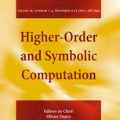We address the need for expanding the presence of the Lisp family of programming languages in bioinformatics and computational biology research. Languages of this family, like Common Lisp, Scheme, or Clojure, facilitate the creation of powerful and flexible software models that are required for complex and rapidly evolving domains like biology. We will point out several important key features that distinguish languages of the Lisp family from other programming languages and we will explain how these features can aid researchers in becoming more productive and creating better code. We will also show how these features make these languages ideal tools for artificial intelligence and machine learning applications. We will specifically stress the advantages of domain-specific languages (DSL): languages which are specialized to a particular area and thus not only facilitate easier research problem formulation, but also aid in the establishment of standards and best programming practices as applied to the specific research field at hand. DSLs are particularly easy to build in Common Lisp, the most comprehensive Lisp dialect, which is commonly referred to as the "programmable programming language." We are convinced that Lisp grants programmers unprecedented power to build increasingly sophisticated artificial intelligence systems that may ultimately transform machine learning and AI research in bioinformatics and computational biology.
翻译:我们还将说明这些特征如何使这些语言成为人造智能和机器学习应用的理想工具。 我们将特别强调特定域语言(DSL)的优势:这些语言是专门针对特定领域的,因此不仅有助于更容易的研究问题的形成,而且还有助于制定适用于具体研究领域的标准和最佳方案制定做法。 DSL特别容易在通用Lisp中建立,这是最全面的Lisp方言,通常被称为“可行的编程语言 ” 。 我们深信,Lisp方案者将赋予日益复杂的人造智能系统前所未有的权力,这些系统最终可能改变机器学习和生物物理和生物学计算中的AI研究。





